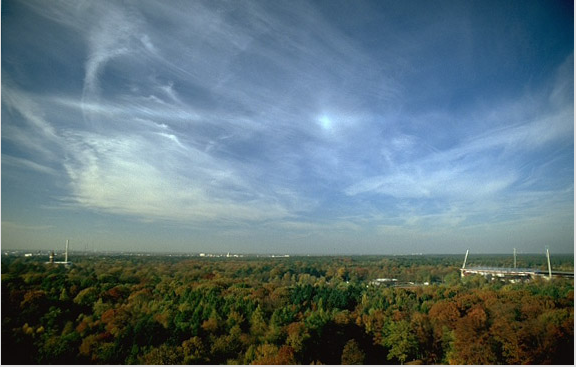120° Parhelia over Karlsruhe, Germany
120° Parhelia over Karlsruhe, Germany: A Rare Atmospheric Phenomenon
Atmospheric optics never fails to amaze us with its stunning displays of light and color. One such rare phenomenon is the occurrence of 120° parhelia, also known as sundogs, over Karlsruhe, Germany. These captivating optical illusions create twin patches of light on either side of the sun, forming an impressive halo-like effect in the sky.
Photographed by Bernhard Möhr, author of The Karlsruhe Cloud Atlas, on October 24th, 1996, the image showcases the extraordinary beauty of this atmospheric event. With the sun shining from the left and at a height of 9.5°, the parhelia were clearly visible and left an indelible impression on those fortunate enough to witness them.
Understanding Parhelia
Parhelia, derived from the Greek words "para" (meaning beside) and "helios" (meaning sun), are optical phenomena caused by the refraction and reflection of sunlight by ice crystals in the atmosphere. These ice crystals are typically found in high-altitude cirrus clouds or diamond dust near the ground.
When sunlight passes through these ice crystals, it undergoes a process known as refraction. The different angles at which light rays are bent create a dispersion effect, similar to what occurs in a prism. This dispersion leads to the separation of colors and the formation of halos, arcs, and other atmospheric optical phenomena.
The Formation of 120° Parhelia
Parhelia are formed when sunlight passes through hexagonal ice crystals with their flat faces parallel to the ground. As light enters one side of the crystal and exits through another, it is bent at specific angles. In the case of 120° parhelia, the light rays are refracted at a particular angle that results in their separation by approximately 120° on either side of the sun.
The symmetry and arrangement of the ice crystals play a crucial role in determining the appearance of the parhelia. In the case of Karlsruhe, Germany, the ice crystals likely had a horizontal orientation, which contributed to the distinct 120° separation of the sundogs.
Atmospheric Conditions and Geographic Factors
Several factors influence the occurrence of 120° parhelia. The presence of cirrus clouds or diamond dust, which contain the necessary ice crystals, is essential. Additionally, the angle of the sun in relation to the observer affects the visibility of parhelia. In the case of the photograph taken in Karlsruhe, the sun was at a height of 9.5°, which allowed for a clear view of the phenomenon.
Geographic location also plays a role in the frequency of parhelia sightings. Karlsruhe, situated in southwestern Germany, experiences a temperate climate with occasional winter precipitation. These conditions provide opportunities for ice crystals to form in the atmosphere, increasing the likelihood of observing atmospheric optical phenomena like parhelia.
The Magic of 120° Parhelia
Witnessing 120° parhelia is truly a magical experience. The vibrant colors and ethereal glow created by these atmospheric phenomena captivate both scientists and nature enthusiasts alike. The occurrence of parhelia serves as a reminder of the intricate beauty and complexity present in our atmosphere.
As sunlight interacts with ice crystals, it undergoes numerous reflections and refractions, resulting in the dispersion and separation of colors. This dispersion creates a stunning display of vibrant hues, ranging from reds and oranges closest to the sun to blues and purples on the outer edges of the sundogs.
Similar Atmospheric Optical Phenomena
Parhelia are just one example of the myriad atmospheric optical phenomena that can occur. Some other notable occurrences include:
- Circumzenithal Arc: A colorful arc that forms above the sun, appearing as an upside-down rainbow.
- Halos: Large rings of light that encircle the sun or moon, caused by the refraction and reflection of sunlight by ice crystals.
- Sun Pillar: A vertical column of light that extends above or below the sun, created by the reflection of sunlight by ice crystals.
Capturing the Beauty of Atmospheric Optics
Photographers and skywatchers around the world strive to capture the beauty of atmospheric optics. The image taken by Bernhard Möhr serves as a testament to the power of photography in preserving these fleeting moments of natural wonder. By sharing these images, we can inspire others to appreciate and learn more about the marvels that occur above us in the sky.
Conclusion
The occurrence of 120° parhelia over Karlsruhe, Germany, on October 24th, 1996, remains a remarkable event in the world of atmospheric optics. These captivating sundogs, formed by the refraction and reflection of sunlight through ice crystals, created a breathtaking display in the sky. Understanding the scientific principles behind parhelia and their formation adds to our appreciation of their beauty. As we continue to explore and study atmospheric optics, we unveil the secrets of our atmosphere and gain a deeper understanding of the wonders that surround us.

120� parhelion over Karlsruhe, Germany. Photographed by Bernhard M�hr, author of The Karlsruhe Cloud Atlas, at 16.10 CET on 24th October 1996 when the sun, shining from the left, was 9.5� high. �Bernhard M�hr reproduced with permission.
Note: this article has been automatically converted from the old site and may not appear as intended. You can find the original article here.
Reference Atmospheric Optics
If you use any of the definitions, information, or data presented on Atmospheric Optics, please copy the link or reference below to properly credit us as the reference source. Thank you!
-
<a href="https://atoptics.co.uk/blog/120-parhelia-over-karlsruhe-germany/">120° Parhelia over Karlsruhe, Germany</a>
-
"120° Parhelia over Karlsruhe, Germany". Atmospheric Optics. Accessed on December 22, 2024. https://atoptics.co.uk/blog/120-parhelia-over-karlsruhe-germany/.
-
"120° Parhelia over Karlsruhe, Germany". Atmospheric Optics, https://atoptics.co.uk/blog/120-parhelia-over-karlsruhe-germany/. Accessed 22 December, 2024
-
120° Parhelia over Karlsruhe, Germany. Atmospheric Optics. Retrieved from https://atoptics.co.uk/blog/120-parhelia-over-karlsruhe-germany/.